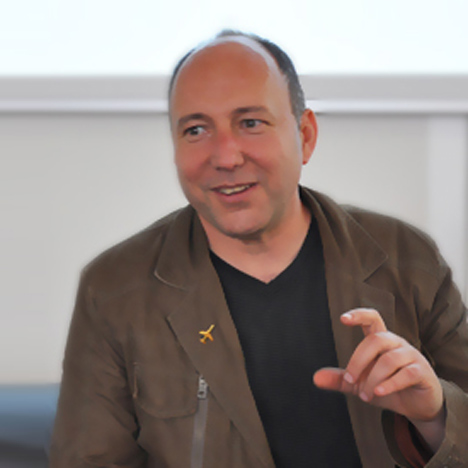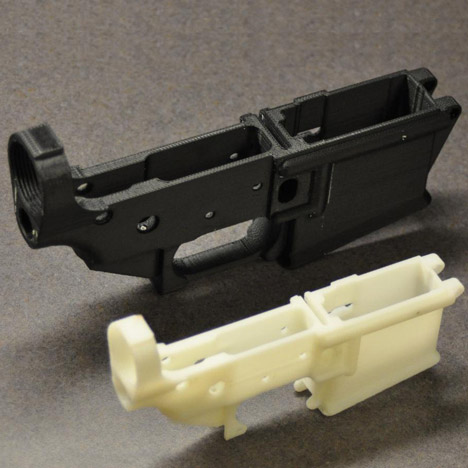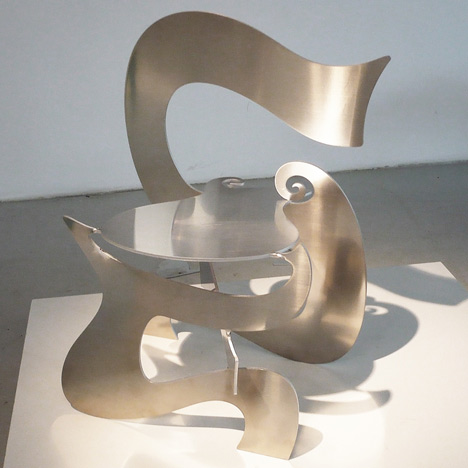
3D printers could "print ammunition for an army"
News: advances in 3D printing could allow people to "print ammunition for an army", according to Ronen Kadushin (pictured above), one of the pioneers of the open design movement.
Kadushin spoke to Dezeen following the news that a pro-gun group in America is developing open-source blueprints for weapons that could be downloaded and printed at home.
"It is frightening for governments because it means the total dissemination of arms into a community," Kadushin said. "You know, you can basically print ammunition for an army, and this is very frightening."
Kadushin said open-source design and the "maker" movement risked being tainted by misuse of new technologies. "All you need is one person that makes a 3D printed weapon, kills somebody with it, and then it goes to the press and the same bad press that hackers have will project onto makers," he said. "This is a very, very dangerous situation."

Above: 3D printed gun components
The Israeli-born designer described the open-source design movement as akin to the hippie movement of the sixties, and said it represented a different approach to the traditional industrial design system. "Maybe in the sixties it was free love, but today it's about free information," he said.
"The industrial design establishment – the system – is much more about the bottom line: about making money from innovation, and not about having any kind of vision about how the human race or human society should progress to the future."
Kadushin, who is based in Berlin and runs a company producing design for furniture, lighting and accessories that are freely available for people to download and adapt, has previously come up with open-source products including a contraceptive device made from a copper coin and a mallet for smashing up iPhones.
Open design emerged as one of the main themes at the Milan furniture fair in April this year – watch our filmed interview with Domus editor-in-chief Joseph Grima about the movement.

Above: Ronen Kadushin's Flat Nouveau chair
Below is a transcript of the interview with Kadushin, conducted by Dezeen editor-in-chief Marcus Fairs in Vienna last week during Vienna Design Week, where Kadushin showed his latest open-source project, a chair cut from a single sheet of aluminium and bent into shape (pictured above).
Marcus Fairs: Tell us about yourself and what you do.
Ronen Kadushin: I'm Ronen Kadushin, I'm a designer, I do open design, and I teach and talk about open design.
MF: Tell us about what open design is and why suddenly there's a lot of discussion about it; why is it suddenly something that people are seeing as a vibrant force in design?
RK: Open design in very plain terms is trying to transform industrial design into a network structure, into a situation where it is in tune with the big vision of humankind today, which is in the internet. And when you think about the internet as the platform to make design or to distribute design, then making design open is a very logical proposition.
MF: And by "open" you mean that anyone can participate?
RK: Yes. A design is basically a piece of information that is on the network, which can be downloaded, changed, produced, copied and so on.
MF: And this is the antithesis of what a lot of brands and designers think of as design: that it's an intellectual property that should be controlled and exploited.
RK: Yes. Industrial design traditionally is about exclusivity, while open design is talking about it being inclusive. And by doing so it is in phase with what is going on in the world. I look at the 99% movement - the Occupy movement - which wants transparency and inclusivity, and I think open design is within this kind of concept about how things should go.
MF: And open design in a way is a bridge between the traditional design community and this new community: the geek community, the maker community, which is many ways perhaps a more exciting community, a more future-focussed community. It's a way of doing things that is having a more profound change on the world than traditional design.
RK: Yes. The maker movement, or makers in general, are not a product of the industrial design education system. They developed their things in the context of open-source software and open hardware, so open design comes very naturally to them. And their society, or their network, is very appreciative of achievement and recognition. You are evaluated, and you are respected by your contribution to the community.
MF: Rather than being the person that did all of the work, and has your stamp on it, it's more like you were an important part of it.
RK: You contribute something that other people will work on and develop and so on, so it's more about the process than the end product.
MF: Tell us about the maker fair you went to, where it felt almost like the hippy movement all over again.
RK: I was at a FabLab conference in Amersfoort in Holland a few weeks ago and making, or being a maker, in that context was more about being ready for the transition - they call it a transition. Writing code, printing 3D products, developing their own tools, doing urban agriculture, urban bee-keeping, recycling, living a sustainable lifestyle - a real sustainable lifestyle - is in context with what they're doing with objects as designers. And it was extremely interesting to live a week within a tribe of technological hippies. Maybe in the sixties it was free love, but today it's about free information.
MF: It sounds like that that kind of community has an idealism, a pioneering spirit that perhaps the traditional design world has lost.
RK: The industrial design establishment - the system - is much more about the bottom line: about making money from innovation, and not about having any kind of vision about how the human race or human society should progress to the future.
MF: Designers often say "I want to change the world'", but there's a limit to how much you can change the world through a slightly different chair shape.
RK: Yeah, I remember very vividly the title of Karim Rashid's book 'I Want to Change the World'. I opened the book and I saw that he wants the world to be pink. And [laughs] I think I would disagree a little with his choice of colours. The world is changing if you want it or not, it's about understanding where it is going, and what you can do about it in a very serious and responsible way, and it's not about the making money side of it. It's more about basically putting out or suggesting a way where the troubles, or the catastrophes that are coming to us will be handled, how they will be met. And part of the solution - in the minds of makers and other open-source communities - is the network. The network is a central part of a proposed solution to this.
MF: And makers, just like designers, tend to be optimistic people, they tend to see the positives of what they're doing, but then there was a story that came out this week about open source guns, about gun enthusiasts in America printing their own weapons to get around restrictions. So all of this can be used for different ends as well, rather than making things better.
RK: Yes, the maker movement is in many ways a double-edged sword: whatever is positive will have also a negative aspect to it, and I think 3D printing of weapons is a proposition that was waiting to come up. Somebody actually made it happen. And you cannot stop it. It is frightening for governments now, because it means the total dissemination of arms into a community. You know, you can basically print ammunition for an army, and this is very frightening. And I don't think it will go all the way in this direction, but I think it brings about possibilities, notions, directions. Nobody will kill anybody with a 3D printed gun soon, I hope. But in the future, you don't know.
MF: But you can guarantee that when it does happen, then the whole network, the whole community you're talking about, the whole notion of Open Design and rapid prototyping will suddenly have a much higher profile than before… but for the wrong reasons.
RK: You know, to make a movement to look bad, all you need is one person that makes a 3D printed weapon, kills somebody with it, and then it goes to the press, and the same bad press that hackers have will project onto makers. This is a very, a very dangerous situation.